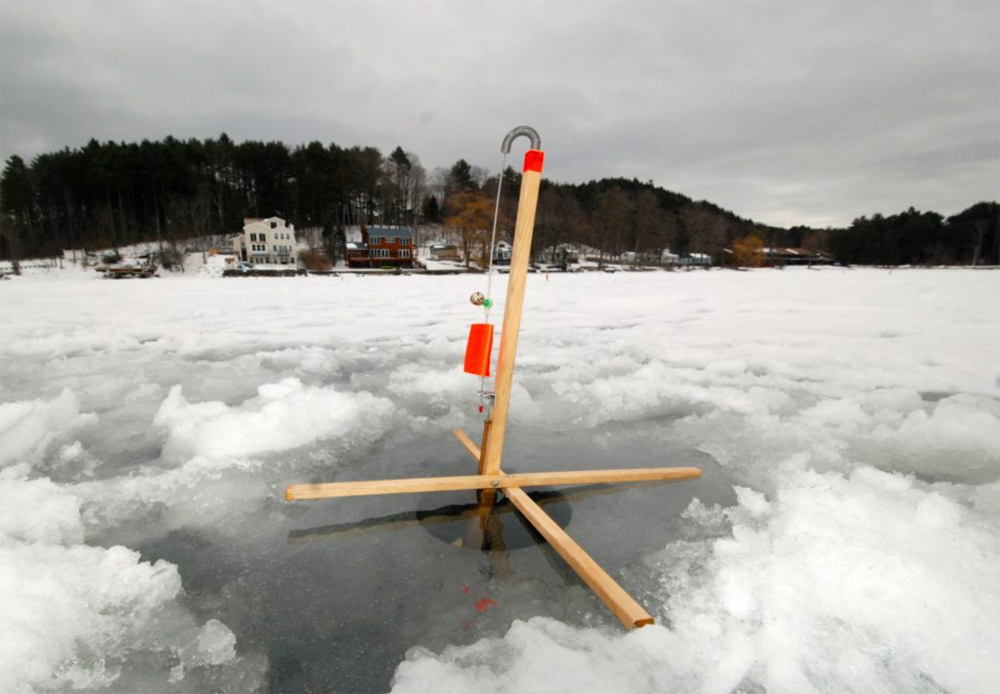

Some 10 years ago, I was introduced to ice fishing with western Massachusetts fishing guide Paul Tawczynski.
On a raw and overcast day in mid-February, I met Tawczynski at snow-covered Lake Laurel in Lee, an hour west of Springfield and roughly two hours from Boston. Tawczynski had already rigged 25 tip-ups over holes the ice, all baited with live shiners, which he had kept alive in buckets treated with a chemical that keeps the water from freezing.

Speaking of freezing, when ice fishing, it’s critical to dress properly—at least if you want to enjoy yourself. Insulated, waterproof boots for the often slushy lake surfaces and layered clothing are a must (most ice-fishing veterans favor snowmobile suits)—and don’t forget ear protection and gloves or mittens. If you decide to get more involved in ice fishing, consider investing in a portable shelter and a propane heater.
Tip, Tip Hooray
The tip-ups we fished were standard-issue wooden jobbers with orange flags that automatically popped up when a fish took the bait.
The reels were spooled with 50-pound-test braided line and a three-foot monofilament leader with a No. 1 hook tied to the end (hook size varies according to the size of the bait and the species being targeted). Tawczynski sometimes attaches a small split-shot sinker several inches above the hook to keep the bait at the desired depth. The shiners, meanwhile, were lightly hooked just ahead of the dorsal fin and above the spine, so as not to impede their swimming ability.
While Tawczynski sometimes fishes small jigs tipped with waxworms for species such as perch, sunfish, and bass when the fish are biting well, the live-bait approach is best for inexperienced anglers and days when the fish are sluggish—which is much of the time. Winter fish do not eat to increase their size, energy, and muscle mass for breeding and competing with rivals or evading predators. Rather, they are simply trying survive the cold, and therefore feed less frequently and aggressively than during the warmer months. They still have to eat, however!
Setting Up
But where to set the lines? Much depends on the species being targeted, but in general you should look for drop-offs, weed beds, rocks, tree stumps, and areas of current flow, such as near the outlet or inlet of a lake or pond. All of these places tend to attract baitfish, which in turn draw predators—just like in the warm months. To locate these spots, consult a bathymetric map (available through the state) or purchase a digital charting apps. In our case, the lines were set in 5 to 20 feet of water and staggered to cover different depths in the hopes of intercepting the fish as they cruised for a meal.
Laurel Lake is noteworthy for containing stocked Atlantic salmon, which can weigh 10 pounds or more. They are an elusive species that tend to cruise just below the ice, and are often spooked by the movements of fishermen above. Catching one is a real challenge. More common are the pickerel, trout, bass, crappie, sunfish, and perch that inhabit most of the lakes and ponds in western Massachusetts.
Like any type of fishing, ice-fishing action is affected by the weather. As during summer, high pressure tends to get the fish feeding more aggressively. On the other hand, low or falling pressure can make for slow days. Some days you need to work hard to catch, while other days you crush ‘em.
I’d like to say that I experienced the latter on my trip with Tawczynski, but alas, the bites were few. Still, I managed to land a small pickerel and several yellow perch before the trip was done, and had picked up loads of information on a fun winter pasttime.
